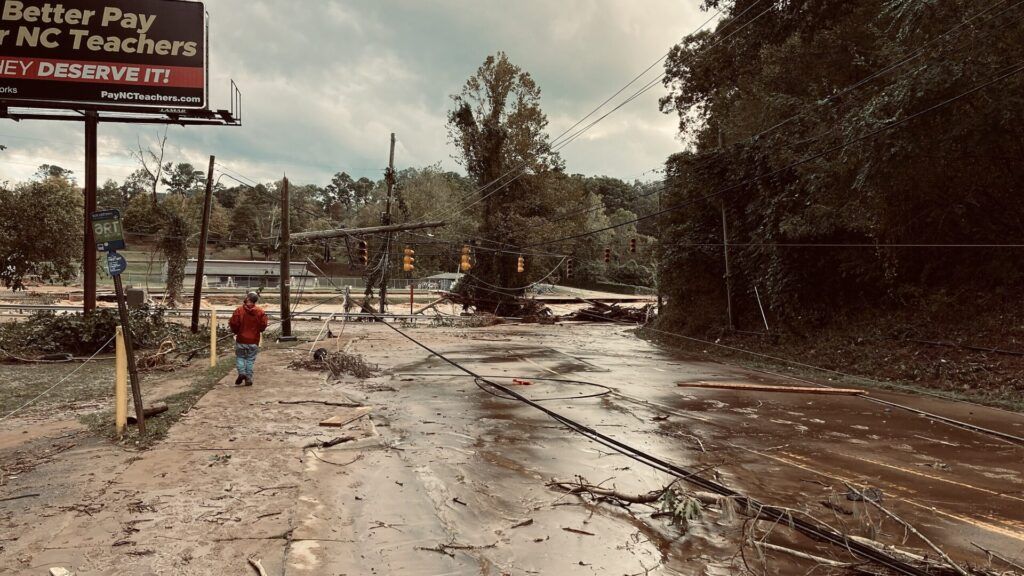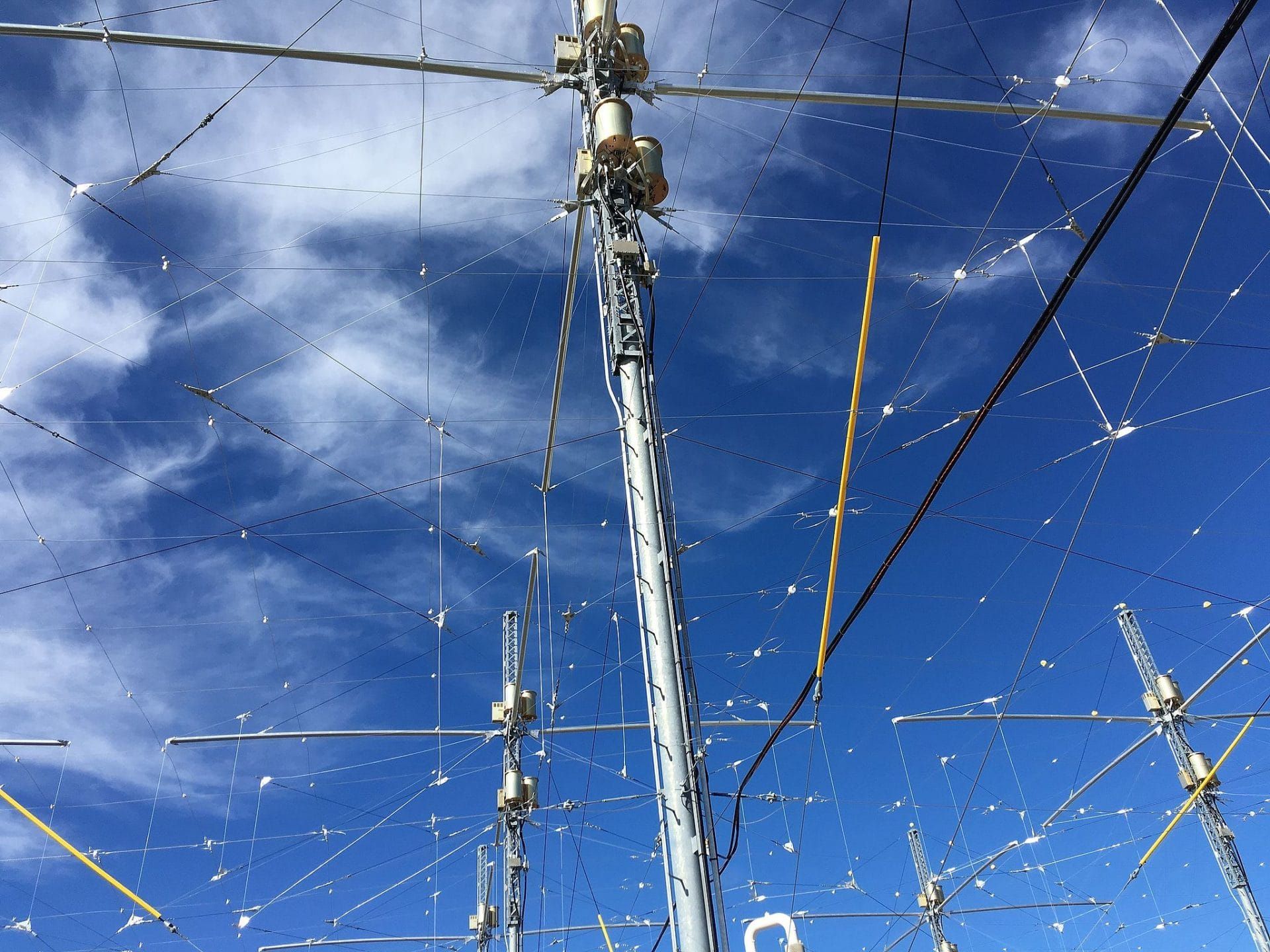The role of the scientist in a post-truth world
By John Morales | October 16, 2024
 Devastation in Asheville, North Carolina, following Hurricane Helene. (Bill McMannis/Flickr)
Devastation in Asheville, North Carolina, following Hurricane Helene. (Bill McMannis/Flickr)
Editor’s Note: This article was originally published in February 2022. Following Hurricane Helene and Hurricane Milton, meteorologists have been subject to harassment and death threats. Conspiracy theories and disinformation are impeding relief work by federal disaster workers in North Carolina. In light of these recent events, we’re republishing this highly relevant piece again now.
The madcap idea to detonate a nuclear bomb inside a hurricane to stop it in its tracks has been around for decades. While this foolhardy suggestion was once entertained by top meteorologists, the scientific consensus is now that it would be disastrous. As Miami weathercaster Don Noe has politely explained: Hurricanes are composed of water, and adding a tremendous amount of heat to a storm that feeds off warm water could result in a monster hurricane that was also radioactive—a not-so-minor complication. NOAA’s succinct conclusion is, “Needless to say, this is not a good idea.”
The forty-fifth president of the United States never got the memo. In 2019, Axios reported, Donald Trump asked national security officials numerous times whether they could look into using nuclear bombs to prevent hurricanes from hitting the country.
When the story was published, I posted this on Twitter: “Over my 35 years as a meteorologist I have received calls & handwritten letters from people proposing this. I gently try to explain to them that according to NASA a hurricane can expend as much energy as 10,000 nuclear bombs during its life cycle. Futile and obviously dangerous.”
Shortly after, producers at NBC Nightly News asked me to provide an on-camera explanation. After initially agreeing to it, I reconsidered. An hour later, I respectfully declined. I was frankly worried about what might happen if I rebuked Donald Trump in front of an audience of eight million, instead of my Twitter following of 100,000.
I am not proud of this. It’s not a profile in courage. But there can and should be limits to every person’s altruistic desire to enlighten or educate if it could potentially bring harm onto them or their family. My dilemma highlights a broader problem facing the nation: How can we function as a free society when built up bitterness against experts leads to threats of physical harm when they denounce pseudoscientific myths? Even if those threats are never acted upon—always an if—the threats themselves are a kind of mental abuse.
I don’t have the answer, but I do know that the solution can’t be one-sided. Attempts to force-feed knowledge to “the masses” will only be met with accusations of elitism and even stronger resistance.
The disturbing new normal. In recent years, formerly fringe ideas have found widespread acceptance among political extremists. Championed by a cult figure with an ardent following, many of these misconceptions have entered the mainstream. From bodily injecting household disinfectants to protect against disease to calling climate change a hoax, as long as the idiotic idea aligns with a certain tribalistic worldview, it’s gospel. And just like the insurrectionists who stormed the capital because they believed the election had been stolen from Donald Trump, some of these conspiracy theorists have shown themselves willing to commit criminal acts based on this misinformation.
In October 2016, two Georgia men were arrested for planning an attack on HAARP—the High-frequency Active Auroral Research Program based in Alaska. HAARP is a high-power radio transmitter aimed at the ionosphere—a part of Earth’s atmosphere that is difficult to study because it’s too high for aircraft and balloons, and too low for satellites. By sending a radio signal up 50 to 200 miles above the surface, scientists and the military look to better understand the effects of solar disruptions on radio communications and GPS positioning guidance.

According to the police, the 30-year-old leader of the plot said that the HAARP device was “trapping human souls.” They planned to hijack HAARP guards and blow up the antennas. When police caught up to them, the men had a cache of assault rifles, thousands of rounds of ammunition, and bullet-proof vests.
Among the swirl of disinformation that thickened into full-fledged conspiracy theories about the device is the false assertion that the United States was using it to control storms that could deliberately damage other countries.
A shred of truth. The United States has in fact experimented with weather modification—in at least one case as a means of warfare—which could explain why this misconception found traction. For example, there was a tropical storm modification experiment between 1962 and 1983 dubbed Project Stormfury in which planes seeded clouds in active hurricanes in an attempt to weaken them. While a small dataset of promising results emerged early on, the project was eventually abandoned. But Stormfury caught Fidel Castro’s attention, who accused the United States of weaponizing hurricanes. He was particularly incensed after 1963’s Category 4 Hurricane Flora looped around the east side of the island so slowly that it dumped 100 inches of rain in Santiago de Cuba, causing massive damage.
While there is no evidence that the American efforts to weaken tropical cyclones backfired on neighboring Cuba, the United States did use the knowledge gained in Project Stormfury in the Vietnam War. Operation Popeye was an Air Force cloud seeding program that ran from 1967 to 1972 aimed at extending the south Asian monsoon season. The goal was to muddy-up the roads and produce landslides, disrupting North Vietnamese supply routes, especially along the Ho Chi Minh Trail.
So people can change the weather, and science-based weather modification techniques are now employed in over 50 countries according to the World Meteorological Organization. But for every science-based weather-altering technique, there are dozens of pseudoscientific urban legends.
In Cuba, it is believed that a shotgun can stop twisters. Aim at the funnel cloud, pull the trigger, and stop the tornado or waterspout before it touches down. In Puerto Rico, people have suggested installing giant fans in the El Yunque rainforest on the east side of the island to blow hurricanes away. Others have suggested putting fans in Africa to increase the amount of Saharan dust that already enters the Atlantic early in hurricane season, which can dampen fledgling tropical storms. The proposal to tow icebergs from the Arctic down to the tropical ocean to cool it down is equally impractical. No flotilla could bring enough rapidly melting icebergs to cool the vast tropical Atlantic Ocean for the six months of hurricane season.
Given all these fantastical ideas perhaps it should come as no surprise that besides altering the weather, conspiracy theorists also claim HAARP can trigger earthquakes, and, as the Georgia men believed, remotely control minds. The line between harmless urban legend and dangerous conspiracy theory is thin.
Made for misinformation. “It’s a completely chaotic time where technology has helped make facts disputable, eroded truth, and crippled trust,” explains Nobel-laureate Filipino journalist Maria Ressa. The Information Age is rife with opportunities for cafeteria-style misinformation-gathering. A recent example is the new “climate lockdown” conspiracy purporting that climate scientists are in cahoots with governments to impose draconian restrictions to reduce citizens’ carbon footprints by prohibiting air travel and meat consumption.
Not only are cable and online media outlets often slanted to give credence to these ideas—frequently succumbing to journalistic “false balance” or “both-sides” storytelling—but individuals who interact with and post about these topics are at the mercy of social media algorithms programmed to feed a growing share of like-minded posts. Before you know it, many find themselves trapped in an identity-affirming feedback loop.
In more innocent times, conspiracy theorists may have been viewed as smoldering embers that could be kept under control, but now their ideas can spread like wildfire. In the post-truth era, objective facts are less influential in shaping public opinion than appeals to emotion and personal belief. Once a narrative that serves a person’s worldview is found, confirmation bias takes over. The radicalization of certain individuals today can happen faster and reach greater extremes thanks to endless and unencumbered access to post-truth information via the World Wide Web. The men planning to unleash an attack on the HAARP facility were radicalized by watching online videos.
Difficult decisions. I chose not to opine about nuking hurricanes on NBC Nightly News to avoid the potential fallout from correcting President Trump on national television. At times I have regretted not standing up for reason that summer evening. But nearly three years later, as I see political extremists gaining clout and increasingly controlling the narrative (and the legislative agenda) at the local, state, and national level, I feel at least justified to not have put my own safety and mental health on the line.
While this personal anecdote may spotlight how sound science communications are being thwarted in the post-truth era, don’t forget that science itself is under a malicious assault as well. Two men planning an assault on a science lab in Alaska is just the tip of the iceberg. Earlier this month, the National Butterfly Center in Texas had to indefinitely close to the public because of escalating social media threats by conspiracy theorists under the delusion that the center is involved in sex trafficking.
Trying to reason with conspiracy theorists can feel pointless, like throwing good information after bad. In 2016, in an attempt to dispel some of the misconceptions about HAARP, officials at the University of Alaska held an open house at the $300 million facility. The paramilitary assault was foiled just three months later.
But dispelling pseudoscientific conspiracy theories is more important today than ever. Attacks on science are being normalized: it can be seen in Trump’s lambasting of climate science, in his followers who revile Dr. Anthony Fauci, and in future leaders like the soon-to-be-confirmed Florida surgeon general who openly questions vaccine safety.
These aren’t embers. It’s a post-truth inferno. And how Americans reckon with it may be one of the biggest challenges of our times. Sound and savvy science communication may be one of the keys to lift us out of the abyss. Scientists and other experts need to meet people where they’re at. I pledge to learn from my timorous refusal to nationally rebuke the president and seek out opportunities to engage locally, both as a public figure and on a personal level. Thousands more of us are needed.
In The Death of Expertise, national security affairs professor Tom Nichols writes, “experts need to remember, always, that they are the servants and not the masters of a democratic society.” So, stop preaching and start talking. Disdain for institutions and expertise can only thaw if we are friend and not foe.
It won’t be easy, and it takes two to tango. I’ve got my olive branch ready. Do you?
Together, we make the world safer.
The Bulletin elevates expert voices above the noise. But as an independent nonprofit organization, our operations depend on the support of readers like you. Help us continue to deliver quality journalism that holds leaders accountable. Your support of our work at any level is important. In return, we promise our coverage will be understandable, influential, vigilant, solution-oriented, and fair-minded. Together we can make a difference.















It is hard to imagine the United States remaining united for decades longer. We all are in echo chambers now, getting endless “proof” of any belief. A people who live in completely different, conflicting, realities can not remain whole. America will break up.
Why are we calling it “post-truth” instead of “blatant lies?”